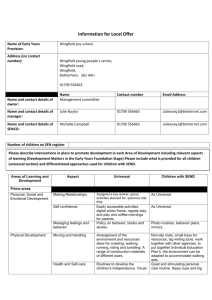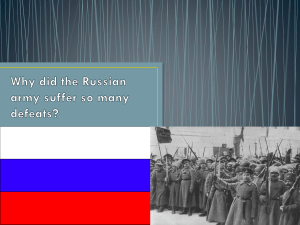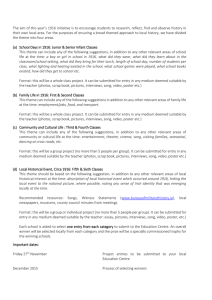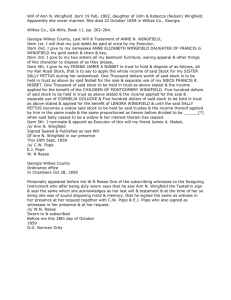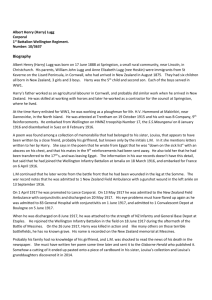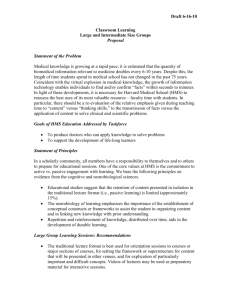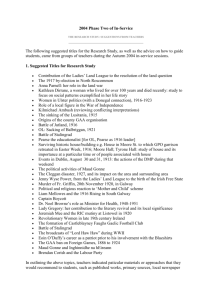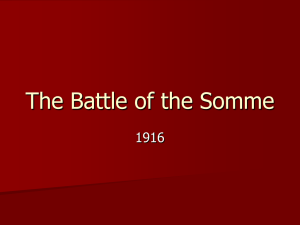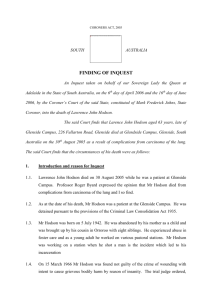Oddington World War 1 Archive 1916
advertisement
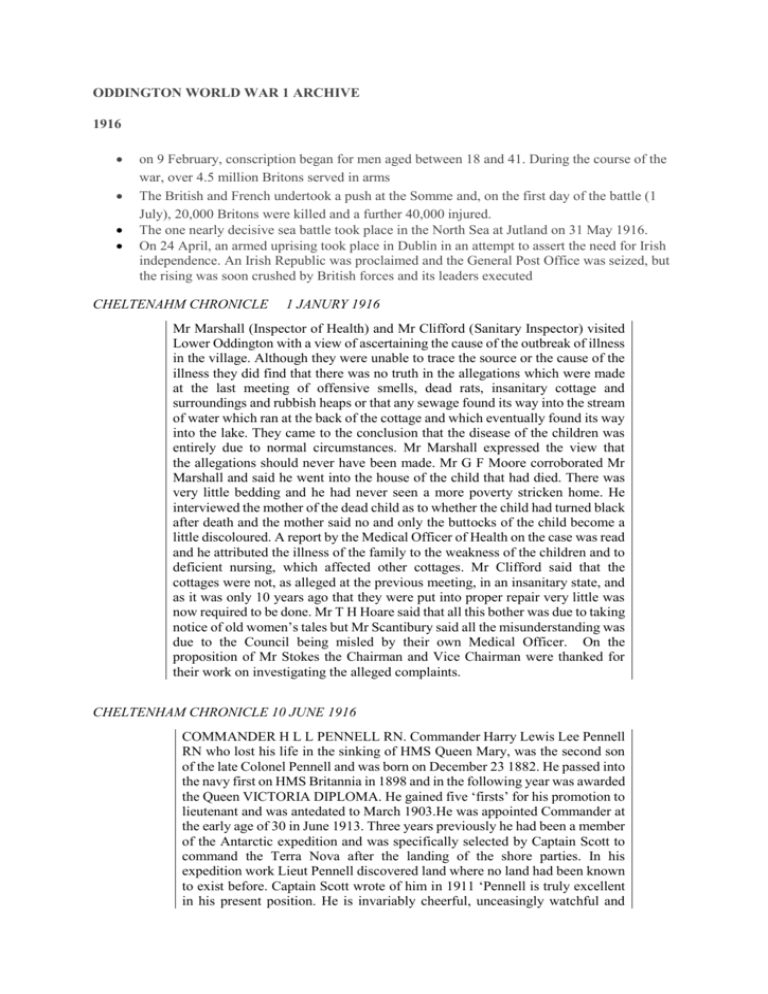
ODDINGTON WORLD WAR 1 ARCHIVE 1916 on 9 February, conscription began for men aged between 18 and 41. During the course of the war, over 4.5 million Britons served in arms The British and French undertook a push at the Somme and, on the first day of the battle (1 July), 20,000 Britons were killed and a further 40,000 injured. The one nearly decisive sea battle took place in the North Sea at Jutland on 31 May 1916. On 24 April, an armed uprising took place in Dublin in an attempt to assert the need for Irish independence. An Irish Republic was proclaimed and the General Post Office was seized, but the rising was soon crushed by British forces and its leaders executed CHELTENAHM CHRONICLE 1 JANURY 1916 Mr Marshall (Inspector of Health) and Mr Clifford (Sanitary Inspector) visited Lower Oddington with a view of ascertaining the cause of the outbreak of illness in the village. Although they were unable to trace the source or the cause of the illness they did find that there was no truth in the allegations which were made at the last meeting of offensive smells, dead rats, insanitary cottage and surroundings and rubbish heaps or that any sewage found its way into the stream of water which ran at the back of the cottage and which eventually found its way into the lake. They came to the conclusion that the disease of the children was entirely due to normal circumstances. Mr Marshall expressed the view that the allegations should never have been made. Mr G F Moore corroborated Mr Marshall and said he went into the house of the child that had died. There was very little bedding and he had never seen a more poverty stricken home. He interviewed the mother of the dead child as to whether the child had turned black after death and the mother said no and only the buttocks of the child become a little discoloured. A report by the Medical Officer of Health on the case was read and he attributed the illness of the family to the weakness of the children and to deficient nursing, which affected other cottages. Mr Clifford said that the cottages were not, as alleged at the previous meeting, in an insanitary state, and as it was only 10 years ago that they were put into proper repair very little was now required to be done. Mr T H Hoare said that all this bother was due to taking notice of old women’s tales but Mr Scantibury said all the misunderstanding was due to the Council being misled by their own Medical Officer. On the proposition of Mr Stokes the Chairman and Vice Chairman were thanked for their work on investigating the alleged complaints. CHELTENHAM CHRONICLE 10 JUNE 1916 COMMANDER H L L PENNELL RN. Commander Harry Lewis Lee Pennell RN who lost his life in the sinking of HMS Queen Mary, was the second son of the late Colonel Pennell and was born on December 23 1882. He passed into the navy first on HMS Britannia in 1898 and in the following year was awarded the Queen VICTORIA DIPLOMA. He gained five ‘firsts’ for his promotion to lieutenant and was antedated to March 1903.He was appointed Commander at the early age of 30 in June 1913. Three years previously he had been a member of the Antarctic expedition and was specifically selected by Captain Scott to command the Terra Nova after the landing of the shore parties. In his expedition work Lieut Pennell discovered land where no land had been known to exist before. Captain Scott wrote of him in 1911 ‘Pennell is truly excellent in his present position. He is invariably cheerful, unceasingly watchful and continuously ready for emergencies. I have come to possess implicit confidence in him’. Commander Pennell received the Royal Geographical Society’s medal in 1913besides the Antarctic medal i1910 -13 and he also had the China medal 1900. After bringing the Terra Nova home to England he was appointed to HMS Duke of Edinburgh, and on her commissioning to HMS Queen Mary. Commander Pennell married on April 12 1915 Catherine Mary only daughter of the late Rev Thomas Hodson rector of Oddington and Mrs Hodson. Harry Pennell salting seal skins in the Antartic 1911 Marriage of Catherine Hodson to Harry Pennell HMS Queen Mary was the last battlecruiser built by the Royal navy before World War She was completed in 1913 and participated in the Battle Of Heligoland Bight as part of the Grand Fleet in 1914. Like most of the modern British battlecruisers, she never left the North Sea during the war. She attempted to intercept a German force that bombarded the North Sea coast of England in December 1914, but was unsuccessful. She was refitting in early 1915, but participated in the largest fleet action of the war, the Battle of Jutland in mid-1916. She was hit twice by the German battlecruiser during the early part of the battle and exploded shortly afterwards, sinking the ship. Her wreck was discovered in 1991 and rests in pieces, some of which are upside down, on the floor of the North Sea. Queen Mary is designated as a protected place as it is the grave of 1,266 officers and men. HMS Queen Mary destroyed at the Battle of Jutland HARRY PENNELL Commander Royal Navy, HMS Queen Mary. Born 1882. Killed in action 1 June 1916 at the Battle of Jutland. Husband of Catherine Pennell (Hodson) Harry and Catherine married in April 1915. Catherine is only daughter of Rev and Mrs Hodson and sister of Hubert Hodson. Died at Battle of Jutland when Queen Mary was sunk with the loss of 1,266 lives. Served in the last South Pole expedition with Cpt Scott 1910-12 where he commanded the Terra Nova. Commemorated at the Portsmouth Naval Memorial. GEORGE GREENWOOD Private. Oxfordshire and Buckinghamshire Light Infantry. Born 1890. Died of wounds 15 January 1916 Son of Edward and Harriet Greenwood of Oxford. Born in Oxford. Moved to Oddington and married Anne Elizabeth Williams at St Nicolas in September 1910. Had one daughter and two sons. Enlisted May 1915. Sent to France in December. Three weeks later he was wounded in the head and died the following day. Buried at Lijsenthock military cemetery in Belgium ARTHUR BARTLETT Lance Corporal. Royal Fusiliers (London Regiment). Born: 1893. Killed in action 1 July 1916. Son of George and Elizabeth Bartlett, Back Lane, Oddington 1915 served in Gallipoli. 1916 evacuated to Egypt then to western front. Buried at Hawthorne Bridge cemetery, France. HUBERT HODSON Private. East Ontario Regiment. Born 1893. Killed 8 May 1916. Son of Rev Thomas Hodson (Rector of Oddington) and Catherine Hudson. Brother in law to Harry Pennell. Emigrated to Canada before the war. Enlisted in Princess Patricia’s Canadian Light infantry. Died at Ypres. Commemorated on the Menin Gate. GRANVILLE WINGFIELD Kings Royal Rifle Corps. Born 1893. Died 12 July 1916. Son of Sybil Wingfield of 19 Hans Place, Sloane Street, London and the late Harry Wingfield, born Moreton-in-Marsh, formerly of Oddington Lodge. Buried in Berks Cemetery Extension, Belgium. EDWARD WILTSHIRE Private Gloucestershire Regiment. Died of wounds 23 July 1916. Born Birmingham. Son of Benjamin and Charlotte Wiltshire. Enlisted at Stow-on-the-Wold Buried Albert Communal cemetery, France. CHELTENHAM CHRONICLE 22 JULY 1916 Sec-Lieut Granville Harry Wingfield of the King’s Royal Rifle Corps, who was killed in action on July 12, was the eldest son of Mr and Mrs Henry Jocelyn Wingfield of Oddington Lodge, and cousin of Capt M E G Rhys Wingfield of Barrington Park. He was 23 years of age. CHELTENHAM CHRONICLE 29 JULY 1916 Lieut Horace Randall Kerr Pechell of the Royal Fusiliers’ who has been wounded is a son of the late Admiral Mark Robert Pechell and a brother of Mrs H J Wingfield of Oddington Lodge, Moreton-in-Marsh. His nephew, Lieut H G Wingfield was reported killed last week. He was born in 1875.

